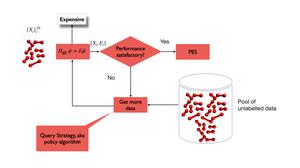Publication on actively learning potential-energy surfaces of molecules
13 October, 2021
Using the Born-Oppenheimer approximation requires potential energy surface (PES) for reliable simulations of nuclear dynamics in molecules. Calculating PESs for weakly-bound complexes is especially difficult and computationally expensive due to the loosely bound nature of the intermolecular interactions, which results in a complicated shape of the PESs with potentially several local minima and saddle points.
In our recent article "Active learning of potential-energy surfaces of weakly-bound complexes with regression-tree ensembles" we proposed and investigated an active learning algorithm that allows for the construction of molecular PESs with reduced computational costs without sacrificing accuracy. The algorithm iteratively selects a small number of molecular geometries that would result in a highly accurate PES after their potential energies are computed and included in the training data (see attached photo). The important feature is that the selection process takes into consideration the trained model's uncertainty regarding the data points as well as the points' representativeness in the data pool. The algorithm was used to construct the PES of the weakly-bound pyrrole-water dimer, where it was shown to outperform other active learning algorithms in the literature.
